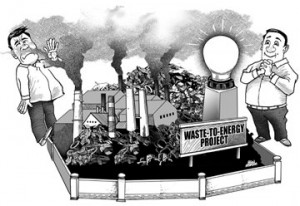
The project proposed by the Greenergy Solutions Inc. (GSI) is packaged as something that is good for the environment.
It has been offered as a long-term solution to Cebu City’s burgeoning solid waste problem. It has also been presented as a climate change mitigation project that is registered under the Clean Development Mechanism (CDM) of the United Nations Framework Convention on Climate Change.
As a CDM project, it is set to gain from carbon gas emission trading aside from the sales of electric power to the National Power Corporation.
The project’s supporters in City Hall are complaining about purported delays by the City Council in approving the waste-to-energy proposal.
With the way the project has been packaged, anyone who appears to be blocking it could be easily accused of obstructionism or being a villain.
But wait, there is more than meets the eye in this project.
The chairperson of the City Council committee on environment, Councilor Nida Cabrera may have turned the can opener.
If indeed the contents of the can are not worms, there should be no worries subjecting the proposal to real scrutiny.
Waste-to-energy projects were not born yesterday.
There was a time when massive burning of garbage was called incineration. Then it was found out that incineration releases in the air some of the deadliest air pollutants called dioxins and furans.
Long before talk of climate change became fashionable, the global community has been setting controls in the emission of these deadly gases classified as Persistent Organic Pollutants or POPs.
POPs are so invasive that they do not only pollute the air, but also the soil and water. And when they enter the food that animals (including humans) eat, they accumulate as they go up the food chain. This is called bio-accumulation of toxins.
Councilor Cabrera may have struck a nerve, albeit a very important note of caution for public welfare and safety when she said that a haphazard approval of the waste-to-energy project proposal is gambling with people’s lives.
“Waste-to-energy projects are considered one of the biggest producers of harmful pollutants if not properly handled,” she said.
Her “teka, teka” on this $102 million proposal is a meaningful pause. While Cebu City’s solid waste problem is critical, investing in a still unexamined technology that could be another fancy name for incineration would not be offering a solution but aggravating a headache.
Make no mistake about it, subjecting the project to further scrutiny is not a matter of petty politics.
Project proponents and their sponsors in City Hall owe it to the public to make full disclosure of the mechanics and impact of the project.
Otherwise, well-positioned marketing strategies and even good intentions can be insulting already.